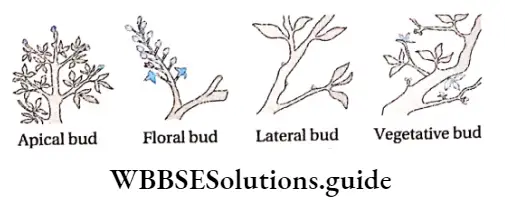The Bud
The Bud Definition: The condensed young shoot tip of the plant, with condensed internodes, surrounded by closely arranged immature leaves one above the other, is known as a bud.
Location: Generally bud develops at the tip of the stem and from the axil of the leaves.
Types of bud:
Different types of buds are discussed as follows—
Based on organs formed from them
- Leaf bud: This type of bud develops only into a leaf.
- Stem bud: This type of bud develops only into a leafy branch.
- Floral bud: This type of bud develops only into a flower.
- Mixed bud: This type of bud can develop into a shoot and flower or inflorescence.
Read and Learn More: WBCHSE Notes for Class 11 Biology
Based on origin and position
Apical/terminal bud: This type of bud occurs at the tip of the stem and branches. The length of the plant increases with the growth of the apical bud.
Lateral bud: This type of bud occurs in different parts of the plant rather than the shoot apex. It is of different types.
Axillary bud: These buds occur at the axils of the leaves and develop into branches.
Some of these buds may remain active and some may remain dormant. The dormant buds can become active when required (for example when the top of the main stem is cut off, the apical bud is removed and the dormant buds start growing). Some buds may fall off instead of developing into shoots, those buds are called deciduous buds.
Accessory bud: Two or more buds may develop above or at the sides of the axillary buds. These are known as accessory buds.
Accessory buds are of two types—
collateral and superposed.
- Collateral bud: These buds grow side by side in the axil. example buds of brinjal.
- Superposed bud: These buds grow one above the other. example Buds of walnut.
Extra axillary bud or supernumerary bud: These buds develop from the nodes but remain outside the leaf base.
Adventitious bud: Sometimes buds may develop from positions other than the normal ones. These buds are called adventitious buds. These are of three types—epiphyllous, cauline, and radical.
Epiphyllous: Buds which develop from the leaves are called epiphyllous buds. example Bryophyllum calycinum and Kalanchoe spathulata.
Cauline: Buds that develop from the cut end of the stem are known as cauline buds. example Rosa centifolia (rose), Duranta plumieri.
Radical: In favorable seasons, some buds develop from roots. These buds are known as radical buds. , for example, Trichosanthes dioica (parwal), and Ipomoea batatas (sweet potato).
Modification of buds: Buds may be modified to perform special functions.
They are as follows—
Thom: In some plants, the buds are modified into thorns. These help to protect the plant from predators. Found in plants like Bougainvillea spectabilis, Duranta plumieri.
Tendril: Buds are modified into tendrils. They help the plants to climb on a support. Found in plants like Vitis quadrangularis, Passiflora suberosa.
Bulbil: Sometimes bud becomes swollen and fleshy due to storage of food. Such swollen buds form a globose structure called bulbil. These structures help in vegetative reproduction. Found in plants like Dioscorea bulbifera, and Globba bulbifera.

Protection of buds:
The buds may be protected from extreme environmental conditions by the following structures—
- In certain plants, such as banyan, jackfruit, Michelia champaca etc., buds are protected by scale leaves.
- In Wormia burbizia, the leaf base protects the buds by covering them as a sheath.

